Table of Contents
Modern living is evolving fast, and so are the tools we use to stay healthy. The way we care for ourselves is shifting, with more focus on comfort and convenience. By 2025, our spaces will do more than just shelter us—they’ll actively support our well-being.
The wellness real estate market is booming, expected to nearly double from $398 billion to $887.5 billion by 2027. This growth reflects a rising demand for living spaces that promote better health. After the pandemic, people now prioritize cleaner air, better sleep, and stress-free environments.
Experts predict nearly half of healthcare services will move into residences within five years. From sleep tracking to air purification, innovations are making it easier to live healthier. The future isn’t just about gadgets—it’s about creating a seamless, supportive ecosystem.
2025 marks a turning point, where tech and health merge effortlessly in daily life. Whether managing chronic conditions or simply boosting relaxation, the right tools can make all the difference.
1. Smart Sleep Solutions for Optimal Rest
Nearly 60% of adults struggle with sleep, but modern tools can help. With 33% getting fewer than 7 hours nightly, optimizing your bedroom is crucial. From lighting to temperature, small changes make a big difference.
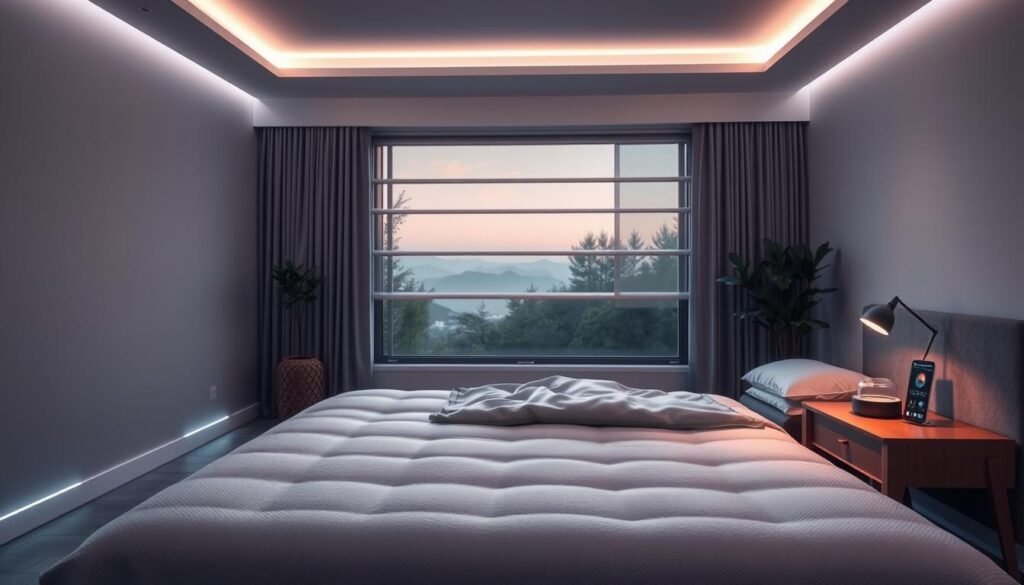
Circadian Lighting Systems
Ketra’s lighting mimics natural sunlight, syncing with your circadian rhythms. Bright mornings and dim evenings signal your body to wake or wind down. This science-backed approach reduces sleep issues linked to artificial light.
Automated Window Treatments
Motorized blackout shades sync with sunrise and sunset. They block disruptive streetlights while gradually letting in dawn light. Perfect for shift workers or light-sensitive sleepers.
Smart Thermostats and White Noise Machines
Ecobee maintains a temperature of 65–68°F, ideal for deep sleep. Pair it with the Hatch Restore 2, offering 30+ soundscapes like rain or ocean waves. Together, they create a consistent, soothing environment.
“57% of tech users experience sleep disruptions—smart bedtime routines can mitigate this.”
Automate routines: dim lights, lower temps, and enable “Do Not Disturb” mode at bedtime. Your devices handle the rest.
2. Enhancing Indoor Air Quality with Smart Tech
The air you breathe indoors could be up to five times dirtier than outdoor air—here’s how to fix it. The EPA warns that pollutants like dust, VOCs, and mold thrive in enclosed spaces. Thankfully, smart devices now detect and eliminate these risks before they harm your health.
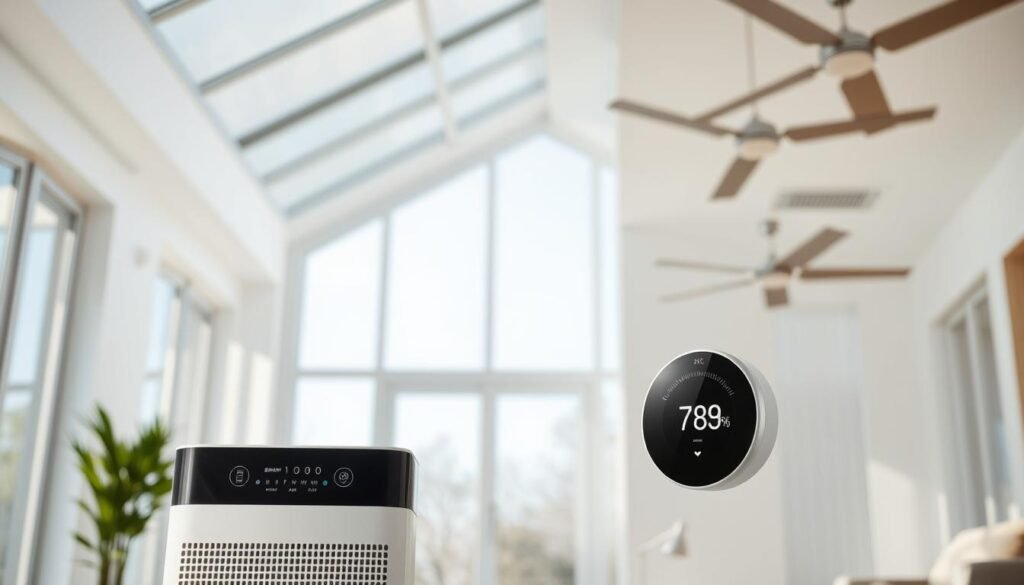
Smart Air Purifiers and Monitors
Devices like the Awair Element track particles as small as 0.1 microns, including CO2 and VOCs. For active purification, the Dyson Purifier Cool TP07 uses HEPA filtration, while Blueair HealthProtect 7470i adds germ-killing tech. HEPA filters trap 99.97% of particles, outperforming standard MERV 13 filters in HVAC systems.
HVAC Integration for Cleaner Air
The iWave-R purifier installs directly into your HVAC, zapping pathogens with ions. Pair it with smart vents like Keen Home to control airflow room by room. This combo reduces energy waste while boosting air quality.
Humidity and Temperature Control
AprilAire’s 8910 WiFi thermostat keeps humidity at 45–55%, preventing mold and dryness. Its app alerts you if levels dip, so you can adjust instantly. Stable temperature and moisture mean fewer allergens and easier breathing.
“3.8 million people die yearly from indoor air pollution, says the WHO.”
Tools like Airthings View Plus offer real-time dashboards, so you’re always informed. With these devices, your space doesn’t just feel cleaner—it is cleaner.
3. Reducing Stress with Home Automation
Daily stress can wear you down, but automation can lighten the load. Studies show 72% of smart lock users feel less anxious, and 68% report sharper focus with automated routines. The right systems turn your space into a sanctuary.
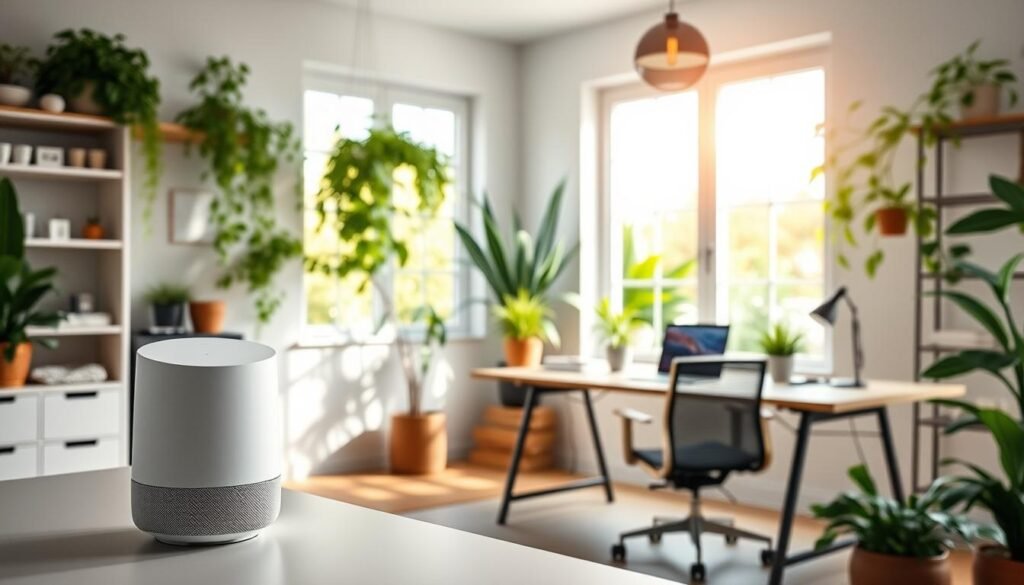
Lighting That Soothes
Soft, adaptive lighting cuts stress. Compare top options:
| Feature | Lutron Caséta | Philips Hue |
|---|---|---|
| Circadian Settings | Yes | Yes |
| Voice Control | Alexa, Google | Alexa, HomeKit |
| Anxiety-Reducing Scenes | Sunset Fade | Relax Gradient |
Lutron’s Sunset Fade gently dims lights over 30 minutes, signaling bedtime. Hue’s voice-activated scenes like “Relax” use warm tones to calm nerves.
Security for Peace of Mind
The Yale Assure Lock 2 lets you ditch keys. Unlock via fingerprint, code, or voice command. Pair it with SimpliSafe’s security system—it cuts false alarms by 98%.
“Burglaries drop by 50% in homes with visible security tech.”
Voice Control Cuts Clutter
Alexa’s Hunches predict forgotten tasks (“Did you lock the door?”). Apple HomeKit’s Focus modes mute non-urgent alerts, reducing digital noise.
Leaks and Hazards Detected Early
Flo by Moen spots leaks as small as 1/100th inch. Google Nest Detect listens for glass breaks or smoke alarms, sending alerts to your phone. These devices act before problems escalate.
Automation isn’t just convenience—it’s a shield against daily stressors.
4. Smart Home Entertainment for Wellness
Your living space can now double as a wellness retreat with the right entertainment tech. Post-pandemic, 63% of homeowners added gyms or recreation spaces, proving leisure and health go hand in hand. From cinematic sound to AI workouts, these features turn downtime into rejuvenation.
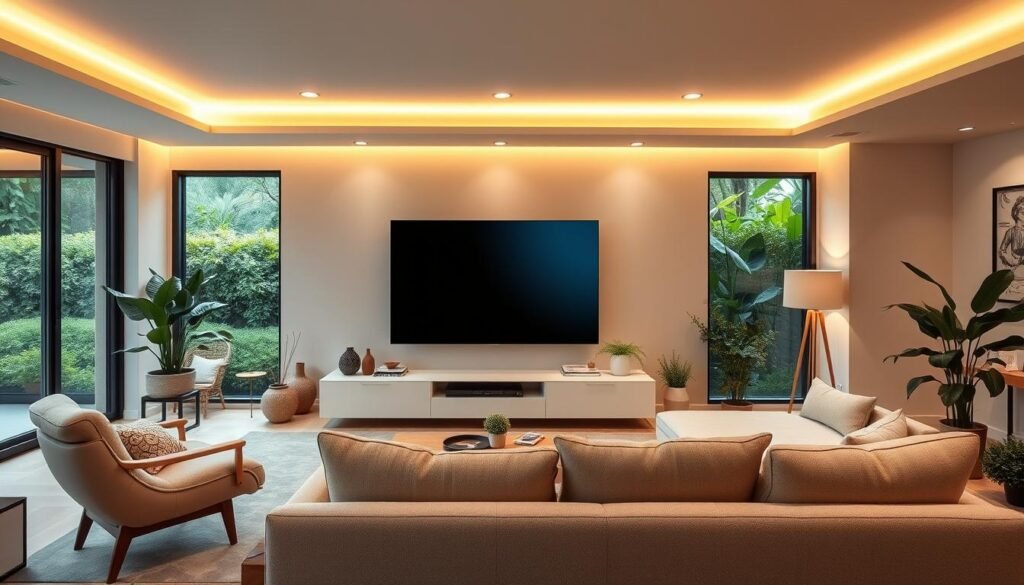
Home Theaters and Immersive Audio
The Sony VPL-XW7000ES 4K laser projector delivers cinema-quality visuals, while Samsung’s The Premiere offers ultra-short-throw convenience. Pair either with the Nakamichi Shockwafe Ultra 9.2.4 system for Dolby Atmos—a setup proven to reduce movie-watching stress by 41%.
Fitness and Recreation Spaces
Tonal’s AI personal trainer adapts reps in real time, and NordicTrack Vault syncs equipment for full-body routines. ThermoSoft’s heated flooring adds comfort to yoga sessions, preventing slips and muscle stiffness.
“Home gym users exercise 48% more frequently than gym-goers.” — First Source
Relaxation and Family Bonding
Fibaro’s multi-sensory meditation rooms sync lighting, sound, and scent for deep calm. For shared time, game nights thrive with Philips Hue’s reactive lighting, syncing colors to on-screen action.
These systems aren’t just about fun—they’re about enhancing your life one moment at a time.
5. Smart Home Wellness Technology for Chronic Conditions
60% of US adults face chronic illnesses—tech is changing how they cope. From wearables to voice assistants, innovative devices now tackle daily health challenges. These tools offer real-time data, safety nets, and independence.
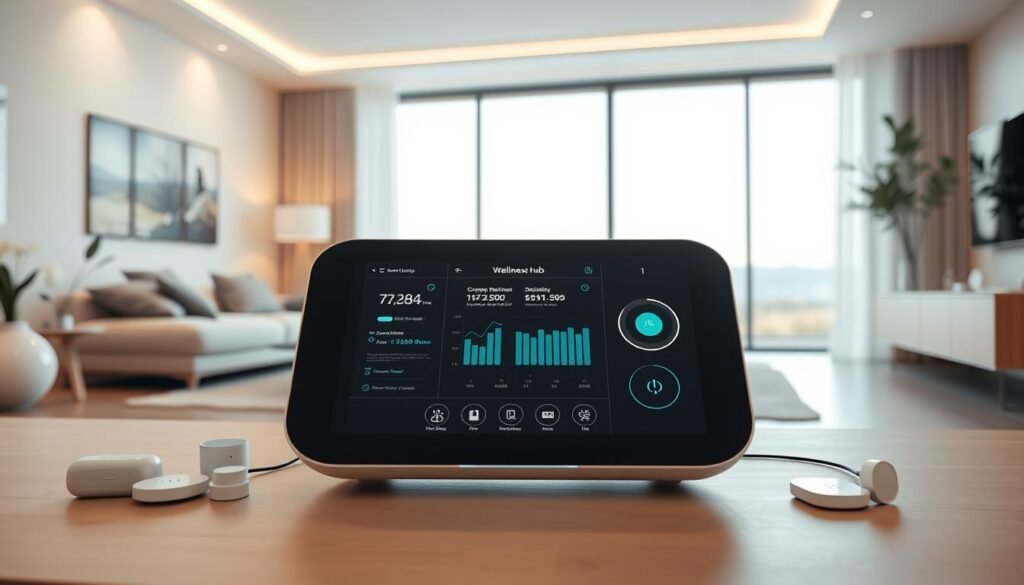
Remote Health Monitoring
Current Health’s FDA-cleared wearable tracks vitals like oxygen levels and heart rate 24/7. Alerts go to doctors if readings spike, preventing emergencies. CarePredict’s AI predicts falls with 94% accuracy using motion sensors.
| Feature | Current Health | CarePredict |
|---|---|---|
| Vitals Monitored | Heart rate, O2, temp | Movement, gait |
| Alert System | Doctor notifications | Family/caregiver alerts |
| Battery Life | 48 hours | 7 days |
Voice-Activated Assistance for Disabilities
Enabling Devices’ voice-controlled hubs adjust lights, locks, and thermostats hands-free. Amazon Alexa Care Hub adds medication reminders and emergency calls. For those with mobility issues, these systems restore control.
“CDC: 6 in 10 adults live with at least one chronic disease.”
Smart Textiles and Biometric Sensors
Myant’s SKIIN underwear embeds ECG and respiration trackers, syncing data to apps. The $5.55B smart textiles market includes socks detecting foot ulcers for diabetics. These innovations blend into daily life, boosting quality life.
Whether managing diabetes or arthritis, today’s technology adapts to individual needs. The future isn’t just treatment—it’s proactive, personalized care.
6. Aging-in-Place with Smart Home Healthcare
77% of older adults choose to stay put—here’s how tech makes it possible. From emergency alerts to adaptive lighting, modern tools empower seniors to live independently while ensuring security and health monitoring. Best Buy’s Geek Squad even installs medical devices, proving aging-in-place is now a mainstream priority.
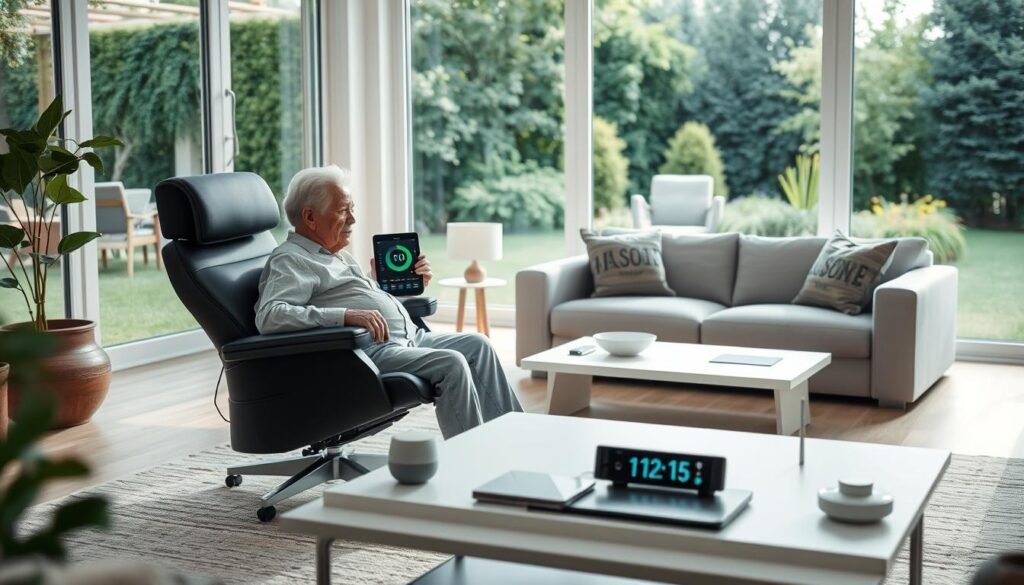
Fall Detection and Emergency Alerts
The LogicMark Guardian Alert 4G pendant detects falls and calls for help with one button. Compare top options:
| Feature | Guardian Alert 4G | Howz Behavior Monitoring |
|---|---|---|
| Fall Detection | Yes (impact + motion) | Activity pattern shifts |
| Emergency Response | 24/7 monitoring | Family alerts |
| Setup | No WiFi needed | Plug-and-play sensors |
Howz’s sensors learn daily routines, flagging unusual inactivity—like missed meals—to caregivers.
Telehealth and Remote Care
GrandCare’s kiosk integrates vitals tracking with video calls to doctors. Patients can share data like blood pressure instantly, cutting clinic visits. AARP reports 90% of seniors want these tools, citing comfort and convenience.
“Home health tech reduces hospital readmissions by 38% for chronic conditions.”
Adaptive Home Modifications
Lutron Serena shades auto-adjust for dementia patients, reducing disorientation. Kohler’s walk-in bath maintains water temperature to prevent burns—a key for those with mobility needs. These systems blend seamlessly, preserving quality life without sacrificing style.
Whether preventing falls or simplifying care, today’s innovations let seniors thrive where they’re happiest: home.